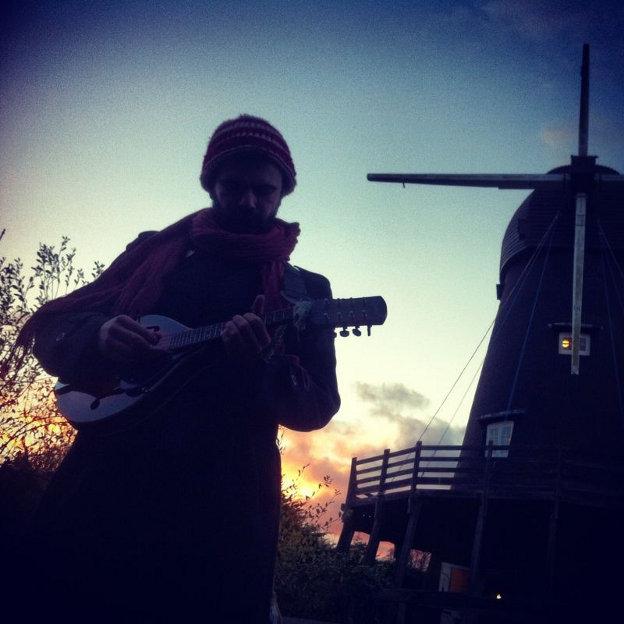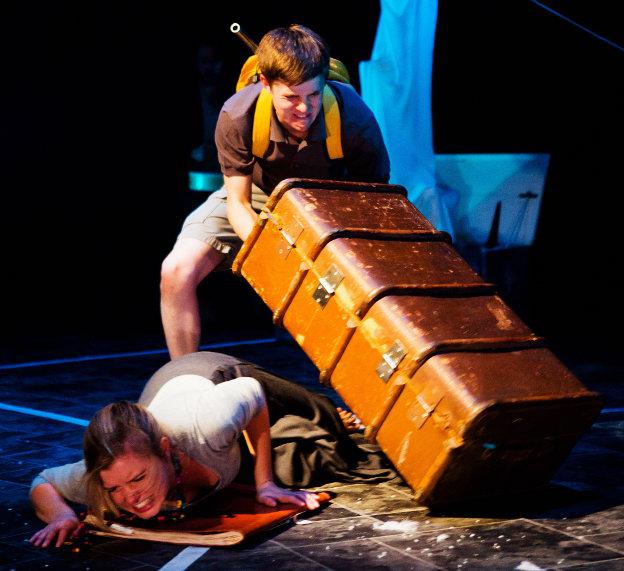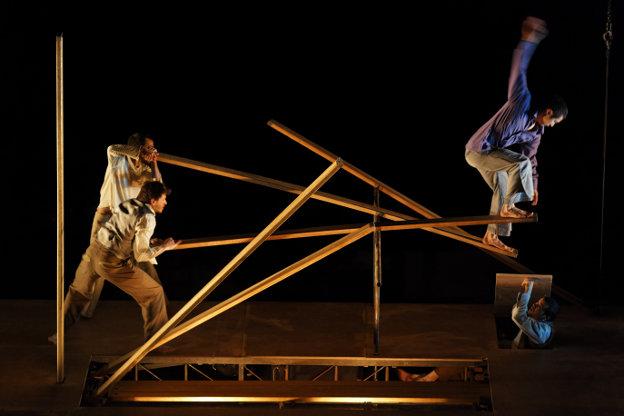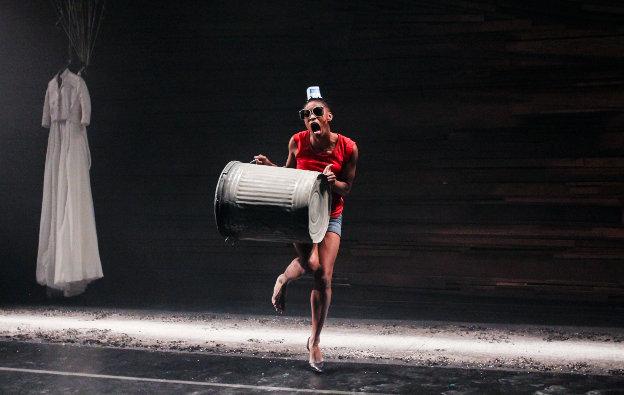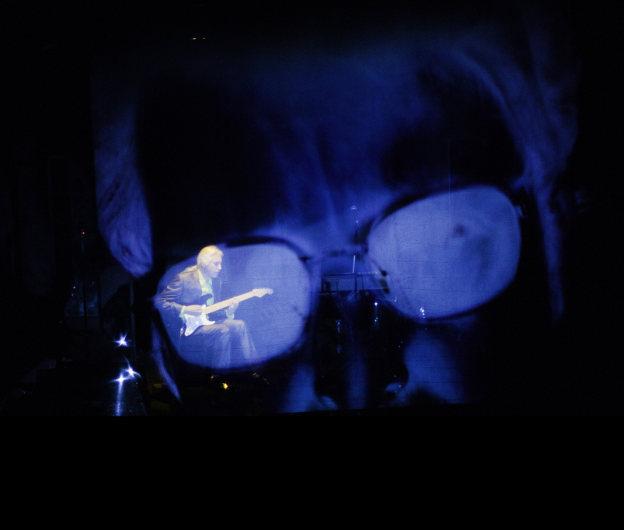I was never able to decide what I wanted to do more, music or theatre. I had been playing an instrument since I was about 9 years old, and I had played in the sort of band that took defiant pride in doing a good cover of Smells Like Teen Spirit. But I had also travelled with my family’s touring pantomime company since I was old enough to hold Cinderella’s glass slipper. To perform seemed natural. Well, to pretend to be deaf when a roomful of children shouted ‘It’s behind you!’ seemed natural. This indecision continued right up to the point of entering university, when I applied to do both theatre and music courses, at separate institutions, reasoning that fate would decide my path. Whichever calling wanted me, I would follow.
Theatre won the toss. And I went to Winchester to become an actor. But I couldn’t repress the desire to play music, and I spent nearly all of my first year in a punk-rock band, growing my hair and completing just enough assignments to pass my course. Acting seemed too pretentious to me then (I occasionally still suffer that feeling), and the cold analysis of old plays by long dead playwrights wasn’t able to satisfy the need I felt for self-expression. I would certainly have rather spent my time as a spectator drunkenly cheering and dancing at a music gig, instead of sitting silently in the dark pondering intellectual quandaries. Arguably I didn’t surround myself with enough good theatre as my folly and my youth urged me to rebel against the institution that theatre represented.
Dusty Preconceptions
There is no doubt in my mind however that many people share the misgivings of my younger self towards theatre; it certainly struggles with a ‘stuffy’ image. I often still wonder why it is that people will flock in their thousands to see a band play a gig, but companies can struggle to fill the smallest venue when they’re advertising theatre. And I think perception has so much to do with it: theatre can be dragged down by its reputation, in the minds of many, as boring, wordy, highbrow art that is more for ‘grown-ups’ than for all. But music has a much more youthful image, exciting and constantly evolving, that speaks to people from all backgrounds. Of course theatre can be all of those things too, but often only to those who work in it or have had regular exposure to its potential. At university I suffered that feeling of apathy towards theatre that plagues so many now, and it looked for a while like I would abandon it in favour of the more seductive mistress of music.
But then a new desire dawned upon me. I had come to terms with the colourful history in my family and I realised I needed to write a play about it. There was something that I needed to say, and the multi-faceted form of theatre was the only way I felt it could be said properly. So I began to write, and as the words came, the music came too.
So I wrote a play called The Ordinaries, a piece about a twisted bouffon family struggling to hide a secret, and I found a partner called Claire to make it with me. Together we formed The River People theatre company in my third year of university. The discovery of other companies such as Welfare State and Bread and Puppet at the same time accompanied a realisation that theatre could be just as exciting and ‘of the moment’ as music is. And my experience in music flourished within our productions as it provided a whole other layer for our storytelling.
With our second production Lilly Through the Dark, a macabre tale of a little girl searching for her father in the land of the dead, music became incredibly vital in my writing. The time spent looking confusedly at music scores in my A-Level paid off as I understood that theatre could be treated like a classical symphony. Each section needed its own rhythm and timbre; themes must be introduced and developed, contrasting shades of tone placed beside each other. It all amounted to the audience developing an understanding of the performance that went beyond the purely intellectual: I was able to bestow upon them a feeling. There is nothing more elusive to describe yet so distinctly clear as a feeling; we seem to understand them on some instinctive level. I realised that by combining music and text along with visuals I was able to transfer a feeling from myself into others, and that became the most rewarding part of my artistic endeavour.
My thoughts return there now as after a year’s break from making theatre I am writing once again. I’m writing a show called Rum Coves and Ragwater. It’s some sort of folky/piratey/cabaret show to be performed by The Waggon Band, which is the eight-piece stompy folk band that spawned as an off-shoot of The River People.
So I’ve been thinking about the unique nature of theatre that has music not just as one of its components but as an essential part of its dramaturgy. It’s an incredibly exciting genre that is breaking new ground and helping to pull theatre away from its dusty preconceptions. There are far too many great companies doing great work for me to hope to name them all, but groups such as Little Bulb, Milk Presents, and Rash Dash are not the least among them.
Walking the elusive line between music and theatre
It’s tricky though, getting the balance right. I want my own work to be fundamentally entertaining, a function that should be the first concern of every theatre-maker. (It seems pretty obvious but I’m amazed at how many seem to forget it.) But that doesn’t mean it can’t be meaningful. I want our audience to think as well as feel, so it should somehow have an application to them personally. I need to get it right, so I’ve been going to see lots of theatrical productions that are particularly music-centric. The problem I’ve often noticed is that the two components of music and theatricality can struggle to match each other: it’s often the case that one element has a stronger presence than the other. Of course there is constant crossover between the two in general within theatre. But when music is set up as a driving force in a theatre performance but is not balanced well in the dramaturgy then the whole thing quickly falls apart like a cake in the shower.
The genre has a wide spectrum and far be it from me to state what is right and wrong, but I have this magic moment in my head (which I have seen fleetingly in many productions) when the elements chime together just right and the music soars – it elevates our understanding of the action, unadulterated entertainment fuses with profound meaning, and the audience go nuts. It’s a moment we’ve perhaps touched on as a company but not something we’ve really nailed. It was in the ending of Lilly Through the Dark: when Lilly let go of the ribbon that held onto the moon, her acceptance of the loss of her father was underpinned by some sweet harmonious humming, a motif that had been building throughout the play. It was one of those moments, when it came off right, when I could feel the audience sharing in Lilly’s revelation. It’s that resonating feeling which we touched upon fleetingly that I’d like to have threaded throughout our new show. So I went out to see as much music/theatre as I could, seeking inspiration.
The Raun Tree, created by Dom Coyote, is an example of a great music gig with strong theatrical leanings. The apocalyptic fairytale is told through ten songs; the band more or less just play them through, and it is the lyrics and the progression of the music that tells the story. It’s the sort of show that, if you went to see it expecting a music gig, would impress you with the amount of theatricality within it. But if you went to see it expecting a theatre show, you would perhaps be disappointed by the lack of theatricality in the presentation. The music alone though evoked a clear feeling of the world Coyote was travelling through; its broad scale and haunting depths gave my ear so much to digest. But the images presented on stage couldn’t keep up with it, and it didn’t touch me as deeply as I wished.
The Tiger Lillies, who are among the legends of music/theatre for their much praised Shockheaded Peter in 1998, even walked the line between the two genres with mixed success in their recent production of Hamlet with Republique Theatre Company. The opening scene did make me gasp with sudden wonder (I’m not often a gasper), and for a few more moments throughout the play they nailed that elusive blend wonderfully. But sadly these moments were fleeting. The rest amounted to a high-quality production of Hamlet with the occasional appearance of the Tiger Lillies, who would perform their usual style of music, which offered a reflection on the themes in the piece but couldn’t drive it along. After a while, they even began to drag it down through their reluctance to provide effective storytelling in the music.
Where to lay the theatrical tracks?
The crux of the challenge is perhaps the decision of where to place the focus of the piece. What carries the performance? Is it the story? Is the story hidden in the songs, or is it in the text? Is the music the focus or does the music just serve to underpin the action? I think if this is clear from the outset then the experience comes together far better.
In Io Theatre’s production of The Snow Spider the focus was clearly on the ensemble storytelling. The music just served to underpin that, which is perhaps why it was so effective when you realised how brilliantly it was composed, and how the cast weaved it effortlessly into the story. It didn’t need to tell the tale itself, it just evoked a feeling and lifted my understanding of the piece to another level.
In a recent piece I collaborated on with the Flanagan Collective, Beulah, the style was very similar. The focus of the piece was the story, which was told didactically in the text. The songs we wrote to punctuate the narrative didn’t need to get any information across; they just needed to capture a feeling that would help to shade the story. By not placing it at the forefront, and gambling the show’s efficacy upon it, the music was able to exceed its expectations and elevate the experience.
Conducting the symphony
Of course it is far easier to compose music for others when you can build upon the themes they have created. It came together so easily in Beulah because all we had to do was be musicians and write some good songs. When I do it for myself I’m being a writer, a musician, a dramaturg and a critic all at the same time. The text spills out of my brain along with the music and the visuals; it’s sometimes hard to know where they should all go. Some sections of text will suddenly make much more sense as a song, and some bits of song sound so much better spoken, and indeed as Claire the co-artistic director of The River People often tells me, it’s sometimes best to shut up and let the images speak for themselves. All the while I’m trying to bottle that elusive feeling that I want to get across and constantly asking myself ‘Is it boring?’.
But we always say, once the script is written, we need a good frame. All productions need a good frame so the audience can understand immediately how to engage with it. The frame could be how storytellers or a narrator greet the audience, the setting or the staging – however we choose to present the first few moments of the piece. The frame might give the focus to the storytelling or the music, but whichever it is, it should be clear from the outset what element the audience should follow primarily. A good frame can make everything better.
But then the magic is created when the other elements are weaved together – how the components of the orchestra clash and build, working both individually and as a whole towards that moment of perfect cadence, where even the most resolute non-gasper can’t help but emit a pale breath. It’s the sort of moment all theatre-makers strive towards, but it seems so much more possible through the subtle alchemy of music and theatre.
So much so that I’m immensely glad my relationship to music and theatre developed as it did, in equal parts. It’s a very exciting area to be working in. I believe it’s the best chance that the theatre industry has to inject new life into an artform that carries the burden of its reputation and struggles to keep up as commercialism and technology expand our options for entertainment.
And as for my own work, I don’t doubt that I’ll crack it eventually. Through judicious application of a frame, a clear driving force, and careful crafting of all the components, one day I shall discover the right ingredients for that perfect cadence that I so emphatically seek.

